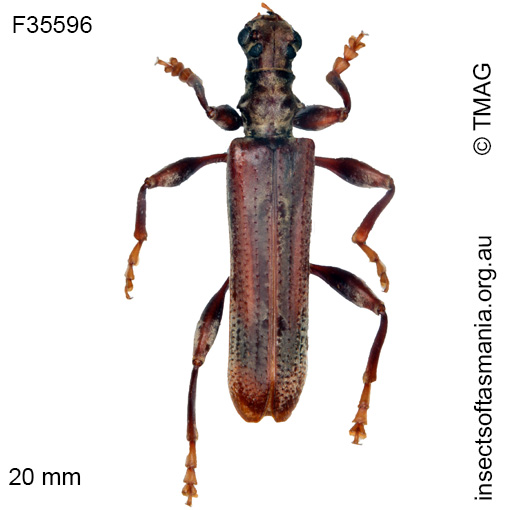
Tessaromma triste
Basis for Tasmanian occurrence
Semmens, T.D., McQuillan, P.B. & Hayhurst, G. (1992). Catalogue of the Insects of Tasmania. Government of Tasmania: Department of Primary Industry, 104 pp. (as Tessaromma sericans)
TMAG collections
Classification
Suborder: Polyphaga
Superfamily: Chrysomeloidea
Family: Cerambycidae
Subfamily: Cerambycinae
Tribe: Tessarommatini
Morphology
Typical length (mm): 20
Flightedness: winged and assumed capable of flight
Source literature on morphology and taxonomy (*primary taxonomic source, where identified):
Erichson, W.F. (1842). Beitrag zur Insecten-Fauna von Vandiemensland, mit besonderer Beruecksichtung der geographischen Verbreitung der Insecten. Nicolai’schen Buchhandlung 8(1): 379 pages.
Ślipiński, A. & Escalona, H. (2016). Australian longhorn beetles (Coleoptea: Cerambycidae), Volume 2: Subfamily Cerambycinae. CSIRO publishing, 640 pp.
Jin, M., Ślipiński, A., De Keyzer, R. & Pang, H. (2017). Review of Australian genera Tessaromma Newman and Phlyctaenodes Newman with description of a new genus and species (Coleoptera: Cerambycidae: Cerambycinae: Phlyctaenodini). Zootaxa 4277(1): 67–85.
Ecology
Association with dead wood or old trees: obligately saproxylic
Ecological attributes: — May occupy logs or trunks of Eucalyptus obliqua, at least temporarily, since found having emerged within a year of felling (Grove & Bashford, 2003) — May occupy logs or trunks of Eucalyptus obliqua, at least temporarily, since found having emerged within six years of felling (Grove et al., 2009).
Collection method(s) for TMAG material: — At light (no trap specified) — At light (with use of light-trap) — Emergence trapping from log of Eucalyptus obliqua — Hand collection (substrate not specified) — Hand collection from Eucalyptus delegatensis — Hand collection from Eucalyptus obliqua — Hand collection from within building — Not specified — Rearing in insectary (host not documented) — Rearing in insectary from Eucalyptus amygdalina — Rearing in insectary from Eucalyptus dalrypleana — Rearing in insectary from Eucalyptus delegatensis — Rearing in insectary from Eucalyptus globulus — Rearing in insectary from Eucalyptus obliqua — Rearing in insectary from Eucalyptus pulchella — Rearing in insectary from Eucalyptus tenuiramis — Rearing in insectary from Eucalyptus viminalis — Rearing in insectary from Leptospermum lanigerum — Vane trapping.
Source ecological literature:
Grove, S.J. & Bashford, R. (2003). Beetle assemblages from the Warra log decay project: insights from the first year of sampling. Tasforests 14: 117-129.
Grove, S. et al. (2009). A long-term experimental study of saproxylic beetle … succession in Tasmanian Eucalyptus … logs… In: Fattorini, S. (Ed.), Insect Ecology and Conservation. Research Signpost, pp. 71-114.

